-
 Bitcoin
Bitcoin $115100
-2.99% -
 Ethereum
Ethereum $3642
-1.38% -
 XRP
XRP $3.027
-5.51% -
 Tether USDt
Tether USDt $1.000
-0.05% -
 BNB
BNB $763.4
-1.32% -
 Solana
Solana $177.2
-5.42% -
 USDC
USDC $0.9999
-0.02% -
 Dogecoin
Dogecoin $0.2247
-6.47% -
 TRON
TRON $0.3135
0.23% -
 Cardano
Cardano $0.7824
-4.46% -
 Hyperliquid
Hyperliquid $42.53
-0.97% -
 Stellar
Stellar $0.4096
-6.09% -
 Sui
Sui $3.662
-2.61% -
 Chainlink
Chainlink $17.63
-3.57% -
 Bitcoin Cash
Bitcoin Cash $536.3
2.94% -
 Hedera
Hedera $0.2450
0.34% -
 Avalanche
Avalanche $23.23
-3.15% -
 Litecoin
Litecoin $112.2
-1.23% -
 UNUS SED LEO
UNUS SED LEO $8.976
-0.30% -
 Shiba Inu
Shiba Inu $0.00001341
-2.72% -
 Toncoin
Toncoin $3.101
-2.44% -
 Ethena USDe
Ethena USDe $1.001
-0.05% -
 Uniswap
Uniswap $10.08
-1.97% -
 Polkadot
Polkadot $3.938
-2.77% -
 Monero
Monero $323.9
0.87% -
 Dai
Dai $0.9999
-0.02% -
 Bitget Token
Bitget Token $4.481
-1.69% -
 Pepe
Pepe $0.00001199
-5.94% -
 Aave
Aave $288.2
-0.68% -
 Cronos
Cronos $0.1279
0.36%
How to confirm the ideal buying point of 1-hour moving average bullish arrangement + 30-minute volume reduction callback to the 5-day line?
A bullish 1-hour MA alignment (5>10>20 EMA) combined with a 30-minute volume-reduced pullback to the 5 SMA signals a high-probability long entry.
Jul 24, 2025 at 02:28 pm
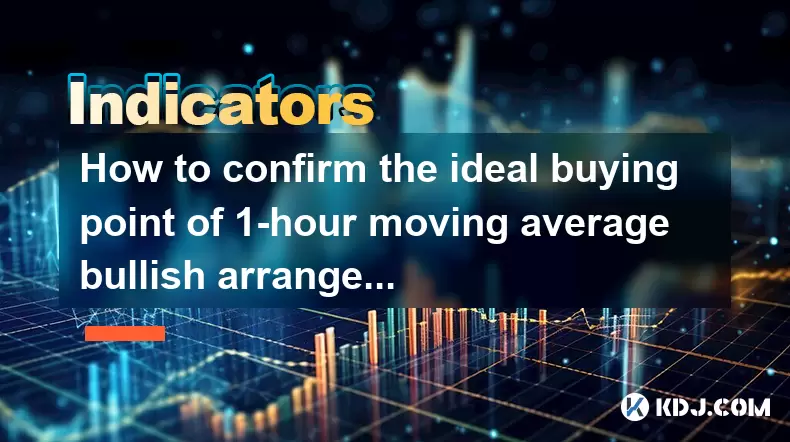
Understanding the 1-Hour Moving Average Bullish Arrangement
The 1-hour moving average bullish arrangement refers to a specific alignment of moving averages (MAs) on the 1-hour chart that signals potential upward momentum. This arrangement typically involves the 5-period, 10-period, and 20-period exponential moving averages (EMAs) forming a stacked order where the shorter-term MA is above the longer-term ones. For instance, the 5 EMA > 10 EMA > 20 EMA configuration indicates a bullish trend structure. This stacking suggests that short-term momentum is stronger than medium-term momentum, which is a favorable condition for entering long positions.
To confirm this arrangement, traders must first ensure the chart is set to the 1-hour timeframe. Then, apply the three EMAs: go to the chart settings, select "Indicators," and add EMA with periods 5, 10, and 20. The color-coding of each EMA should be distinct for easy identification. Once plotted, observe whether the lines are in ascending order from top to bottom. The 5 EMA must be on top, followed by the 10 EMA, and then the 20 EMA beneath. This visual confirmation is essential before proceeding to the next condition.
It’s important to note that a temporary crossover does not guarantee a stable arrangement. Traders should wait for the MA lines to remain in this order for at least two consecutive candlesticks to reduce false signals. Also, the slope of the 5 EMA should be visibly upward, reinforcing the strength of the bullish trend. If the MAs are flat or slightly descending, the arrangement may not be reliable, even if the order appears correct.
Identifying Volume Reduction on the 30-Minute Chart
After confirming the bullish MA arrangement on the 1-hour chart, the next step is to analyze the 30-minute chart for volume reduction. Volume plays a critical role in validating price movements. A decrease in volume during a pullback suggests that selling pressure is weakening, which increases the likelihood of a bullish continuation.
To monitor volume, ensure the volume indicator is enabled on the 30-minute chart. Most trading platforms display volume as a histogram below the price chart. Look for a recent price decline—this is the "callback"—and compare the volume bars during this drop to the volume bars during the preceding uptrend. The ideal scenario is when the volume bars during the pullback are significantly shorter than those during the upward movement.
Volume reduction must occur over at least two consecutive 30-minute candles. A single low-volume candle is not sufficient. The reduction should coincide with the price moving toward the 5-day moving average (MA) on the 30-minute chart. This MA acts as a dynamic support level. The convergence of lower volume and price approaching the 5 MA increases the probability of a bounce.
Locating the 5-Day Moving Average Callback
The 30-minute 5-day moving average is a key support level in this strategy. It is calculated based on the closing prices of the last five trading days, with each day consisting of 48 thirty-minute candles. To apply it, add a simple moving average (SMA) with a period of 5 to the 30-minute chart. Ensure the chart is set to display days correctly, so the 5-day MA reflects actual calendar days.
When the price pulls back, it should approach or touch this 5 SMA without breaking below it decisively. A touch or shallow penetration followed by immediate reversal is acceptable, but a close below the 5 SMA on a 30-minute candle invalidates the setup. Traders should watch the price action closely as it nears this level.
The ideal callback occurs when the price reaches within 0.3% to 0.5% of the 5 SMA. For example, if the 5 SMA is at $30,000, the price should dip to between $29,850 and $29,910. This proximity indicates strong support. Additionally, the candle that touches the 5 SMA should show signs of rejection, such as a long lower wick or a bullish engulfing pattern.
Combining Both Conditions for Entry
The ideal buying point emerges only when both the 1-hour bullish MA arrangement and the 30-minute volume-reduced callback to the 5 SMA are simultaneously present. This confluence increases the reliability of the trade signal.
- Check that the 1-hour EMAs are in bullish order and have been stable for at least two candles.
- Switch to the 30-minute chart and confirm the price has pulled back with declining volume.
- Ensure the price has reached the 5 SMA on the 30-minute chart.
- Wait for a bullish reversal candle to form at the 5 SMA, such as a hammer or bullish engulfing pattern.
- Enter the trade at the close of the reversal candle or the open of the next candle.
Place a stop-loss just below the low of the reversal candle or slightly under the 5 SMA, typically 0.5% to 1% below entry. This protects against false breakouts. Position size should align with risk tolerance, ensuring no more than 1-2% of capital is at risk per trade.
Practical Example Using a Cryptocurrency Pair
Suppose you are analyzing BTC/USDT on Binance. On the 1-hour chart, the 5 EMA is at $43,200, the 10 EMA at $43,000, and the 20 EMA at $42,800. The order is correct, and all are sloping upward. This satisfies the first condition.
Switching to the 30-minute chart, BTC rises from $42,500 to $43,300 over six candles with strong volume. It then pulls back to $42,700 over three candles. The volume bars during this drop are visibly shorter than during the rise. The 5 SMA on this chart is at $42,680. The price touches $42,700, which is within 0.5% of the SMA.
The third 30-minute candle forms a hammer with a long lower wick and closes near its high. This is the reversal signal. The buy entry is set at $42,720, just above the hammer’s close. The stop-loss is placed at $42,500, below the 5 SMA and the hammer’s low.
Frequently Asked Questions
What if the 1-hour MA arrangement is bullish but the 30-minute price hasn’t reached the 5 SMA?
Wait for the price to approach the 5 SMA. Entering before the callback increases risk, as the pullback may not have completed. Patience ensures alignment with both conditions.
Can I use EMA instead of SMA for the 30-minute 5-day line?
Yes, some traders prefer the 5-period EMA on the 30-minute chart for quicker response. However, the SMA is less prone to whipsaw and may provide more reliable support in choppy markets.
How do I adjust for low-volume cryptocurrencies?
In low-volume assets, volume reduction may be less pronounced. Focus on relative volume changes rather than absolute levels. Compare the current volume to the 10-candle average to identify meaningful drops.
Does this strategy work during major news events?
Extreme volatility from news can distort MA behavior and volume patterns. It is advisable to avoid trading this setup during high-impact announcements such as Fed decisions or exchange outages, as the usual technical signals may fail.
Disclaimer:info@kdj.com
The information provided is not trading advice. kdj.com does not assume any responsibility for any investments made based on the information provided in this article. Cryptocurrencies are highly volatile and it is highly recommended that you invest with caution after thorough research!
If you believe that the content used on this website infringes your copyright, please contact us immediately (info@kdj.com) and we will delete it promptly.
- Kiyosaki's Crypto Playbook: Ditching Paper for Real Assets Like Bitcoin
- 2025-07-25 22:30:11
- Satoshi-Era Whales Stir the Bitcoin Pot: What's the Deal?
- 2025-07-25 22:30:12
- Pi Coin Value in Indian Rupees (INR) 2024: Decoding the Hype
- 2025-07-25 21:45:50
- Crypto Investing: Top Picks and Meme Coin Mania in '25
- 2025-07-25 21:52:07
- Ark Invest's Portfolio Rebalance: Coinbase, Block, and the Crypto Shift
- 2025-07-25 21:52:07
- Bitcoin's Wild Ride: Sell-offs, Volatility, and What's Next
- 2025-07-25 21:55:18
Related knowledge

How to interpret that the KDJ D line is downward for a long time but the price is sideways?
Jul 25,2025 at 07:00pm
Understanding the KDJ Indicator and Its ComponentsThe KDJ indicator is a momentum oscillator widely used in cryptocurrency trading to assess overbough...

What does it mean that the KDJ indicator forms a double bottom at a low level?
Jul 25,2025 at 05:08pm
Understanding the KDJ Indicator in Cryptocurrency TradingThe KDJ indicator is a momentum oscillator widely used in cryptocurrency trading to identify ...
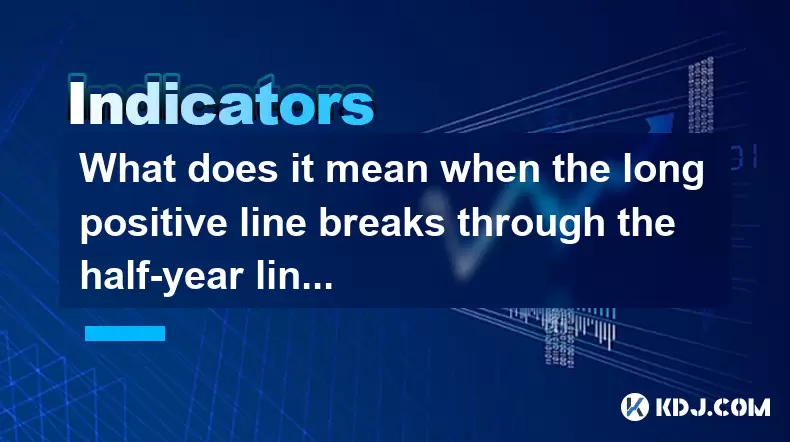
What does it mean when the long positive line breaks through the half-year line and then steps back?
Jul 25,2025 at 06:49pm
Understanding the Long Positive Line in Candlestick ChartsIn the world of cryptocurrency trading, candlestick patterns play a vital role in technical ...
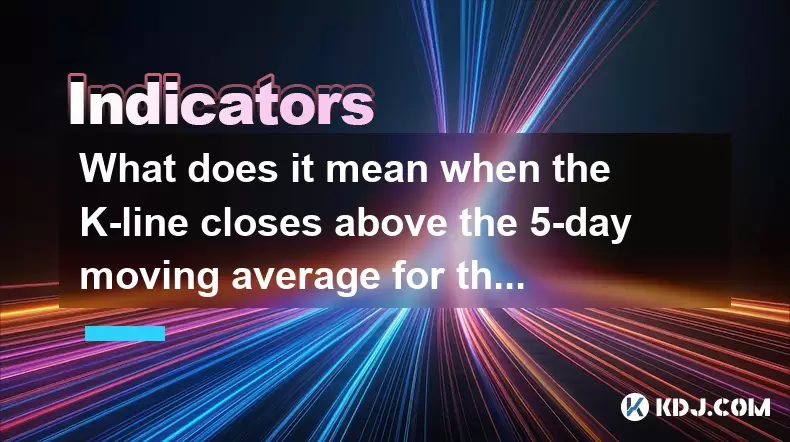
What does it mean when the K-line closes above the 5-day moving average for three consecutive days?
Jul 25,2025 at 10:07pm
Understanding the K-line and 5-day Moving AverageThe K-line, also known as a candlestick, is a critical charting tool used in technical analysis to re...
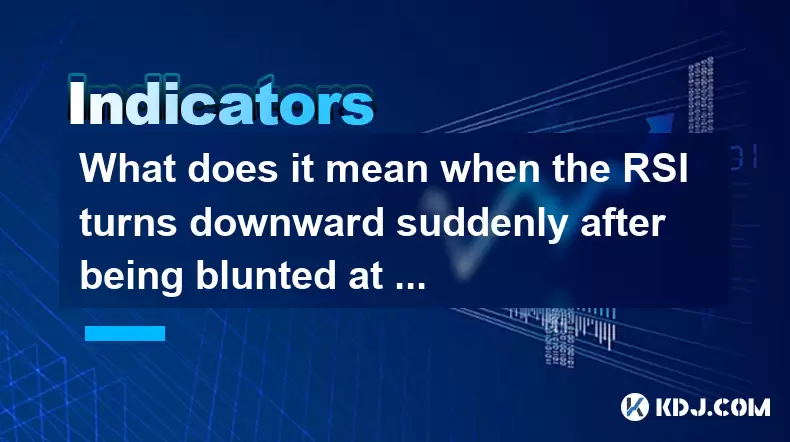
What does it mean when the RSI turns downward suddenly after being blunted at a high level?
Jul 25,2025 at 04:00pm
Understanding the RSI and Its Role in Technical AnalysisThe Relative Strength Index (RSI) is a momentum oscillator that measures the speed and change ...
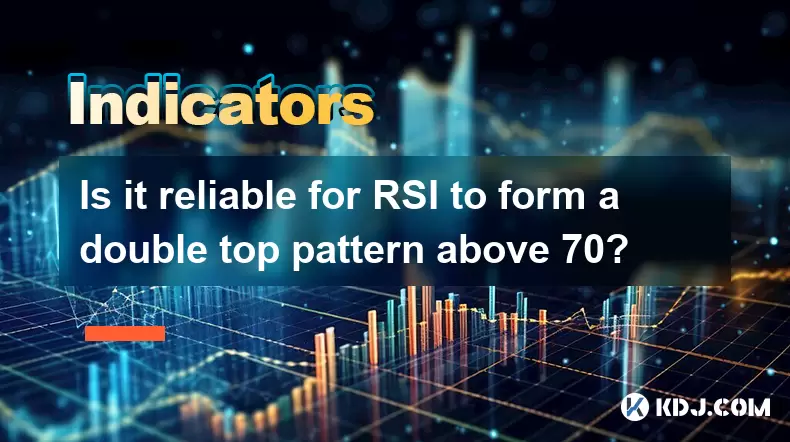
Is it reliable for RSI to form a double top pattern above 70?
Jul 25,2025 at 04:49pm
Understanding the RSI Indicator and Its Role in Technical AnalysisThe Relative Strength Index (RSI) is a momentum oscillator that measures the speed a...

How to interpret that the KDJ D line is downward for a long time but the price is sideways?
Jul 25,2025 at 07:00pm
Understanding the KDJ Indicator and Its ComponentsThe KDJ indicator is a momentum oscillator widely used in cryptocurrency trading to assess overbough...

What does it mean that the KDJ indicator forms a double bottom at a low level?
Jul 25,2025 at 05:08pm
Understanding the KDJ Indicator in Cryptocurrency TradingThe KDJ indicator is a momentum oscillator widely used in cryptocurrency trading to identify ...

What does it mean when the long positive line breaks through the half-year line and then steps back?
Jul 25,2025 at 06:49pm
Understanding the Long Positive Line in Candlestick ChartsIn the world of cryptocurrency trading, candlestick patterns play a vital role in technical ...

What does it mean when the K-line closes above the 5-day moving average for three consecutive days?
Jul 25,2025 at 10:07pm
Understanding the K-line and 5-day Moving AverageThe K-line, also known as a candlestick, is a critical charting tool used in technical analysis to re...

What does it mean when the RSI turns downward suddenly after being blunted at a high level?
Jul 25,2025 at 04:00pm
Understanding the RSI and Its Role in Technical AnalysisThe Relative Strength Index (RSI) is a momentum oscillator that measures the speed and change ...

Is it reliable for RSI to form a double top pattern above 70?
Jul 25,2025 at 04:49pm
Understanding the RSI Indicator and Its Role in Technical AnalysisThe Relative Strength Index (RSI) is a momentum oscillator that measures the speed a...
See all articles

























































































